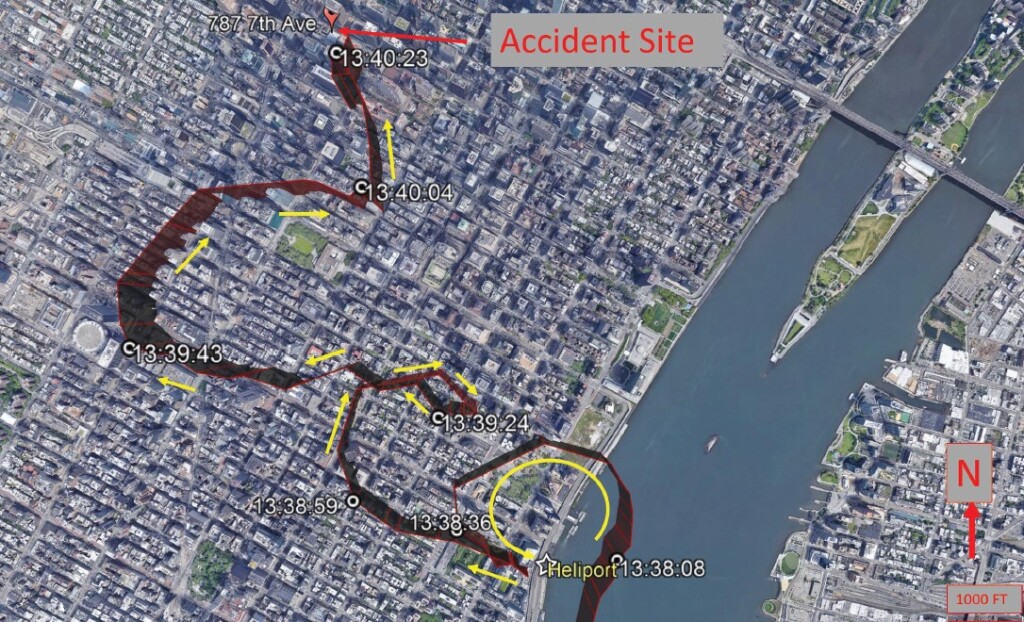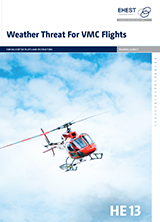Erratic Flight in Marginal Visibility over New York Ends in Tragedy (Agusta A109E N200BK)
On Monday 10 June 2019 private Leonardo A109E N200BK crashed on to the roof of a 54 storey New York skyscraper killing the pilot, the sole occupant after an erratic flight in poor visibility. No one on the ground was harmed.
The US National Transportation Safety Board (NTSB) explain in their safety investigation report (issued 9 February 2022) that the pilot had 2805 hours total time (but they don’t specify the time on type) and had worked for the company that owned the helicopter for about 5 years. That company was owned by the passenger, who had previously disembarked, who was also a pilot.
As the pilot was preparing the helicopter for the flight [earlier that day]…he informed his brother that he was nervous about the flight due to the poor weather conditions. His brother suggested that he not fly the trip, the pilot responded that “[the pilot-rated passenger] is making me fly.” About 1200, during a telephone conversation while at 6N5 [the East 34th street heliport], the pilot told his girlfriend that he had a “window” to reposition the helicopter to LDJ [Linden Airport, NJ], and also said that he “shouldn’t be flying, but had to…”
After dropping off a passenger during a routine weekly commuting flight, the noninstrument-rated pilot of the helicopter remained at the fixed-base operator (FBO) for about 2 hours, reviewing weather information before departing on the planned repositioning flight, which was the last flight leg of the commute [to LDJ, where the helicopter waited until Friday to reverse the journey]. While there, he was continuously checking weather conditions using his tablet computer. Before he departed, the pilot informed FBO staff that he saw a “twenty-minute window to make it out.”
Significantly:
According to staff at the FBO at 6N5, fees that would have been incurred for the helicopter to remain at 6N5 started at $200 per hour, with an overnight fee of $250…
However:
The extent to which those fees or other factors, such as the pilot’s obligation to reposition the helicopter as part of the normal commute, influenced his decision to depart could not be determined.
The NTSB explain that the Part 91 corporate flight…
…departed into marginal visual flight rules (MVFR) conditions, and soon after takeoff, encountered instrument meteorological conditions (IMC). Although the pilot communicated that he was attempting to return to the departure heliport; shortly thereafter, he transmitted to heliport staff that he didn’t know where he was.”
Flight track data depicted an erratic flight path after takeoff, during which the helicopter climbed above the reported cloud base of 500 ft above ground level, and witness video recordings showed the helicopter flying in and out of clouds.
About 8 minutes after takeoff, the helicopter descended rapidly and impacted the roof of a building.
Examination of the wreckage on the rooftop revealed that all major components of the helicopter were present at the accident site and were confined to an area about 100 ft long and 20 ft wide…
No preimpact anomalies with the helicopter were found by investigators, who comment that:
The pilot’s decision to depart into MVFR conditions and the helicopter’s subsequent encounter with IMC were conducive to the development of spatial disorientation, and the helicopter’s erratic flight path and rapid descent were consistent with a loss of control due to spatial disorientation.
NTSB Probable Cause
The non-instrument-rated pilot’s decision to initiate the flight into marginal visual flight rules and instrument meteorological conditions, which resulted in spatial disorientation and a subsequent loss of control.
Safety Resources
The European Safety Promotion Network Rotorcraft (ESPN-R) has a helicopter safety discussion group on LinkedIn. You may also find these Aerossurance articles of interest:
- A Short Flight to Disaster: A109 Mountain CFIT in Marginal Weather
- CFIT Gangnam Style – Korean S-76C++ and Decision Making
- NTSB Investigation into AW139 Bahamas Night Take Off Accident
- Fatal Night-time UK AW139 Accident Highlights Business Aviation Safety Lessons
- HEMS AW109S Collided With Radio Mast During Night Flight
- An AW109SP, Overweight VIPs and Crew Stress
- Final Report: AS365N3 9M-IGB Fatal Accident
- Fatal Helicopter / Crane Collision – London Jan 2013
- HEMS A109S Night Loss of Control Inflight
- Air Ambulance A109S Spatial Disorientation in Night IMC
- NTSB on LA A109S Rooftop Hospital Helipad Landing Accident
- Inexperienced IIMC over Chesapeake Bay (Guimbal Cabri G2 N572MD): Reduced Visual References Require Vigilance
- Plan Continuation Bias & IIMC in Kenyan Police AW119 Accident
- Loss of Bell 412 off Brazil Remains Unexplained
- Air Methods AS350B3 Night CFIT in Snow
- Grey Charter in French Guiana: IIMC and LOC-I
- UPDATE 12 March 2022: Black Hawk Scud Running in Tennessee: IIMC & CFIT
- UPDATE 18 June 2022: Limitations of See and Avoid: Four Die in HEMS Helicopter / PA-28 Mid Air Collision
- UPDATE 25 June 2022: NYPD B429 Accident at Manhattan Heliport “Overapplication of Flight Controls”
- UPDATE 30 August 2025: Flat Light B206L4 Alaskan CFIT & 11 Hour Emergency Response Delay
EHEST Leaflet HE 13 Weather Threat For VMC Flights:
The NTSB held a board meeting in February 2021 that determined that the pilot’s decision to continue VFR flight into IMC, resulting in spatial disorientation and a loss of control, led to the fatal 26 January 2020 crash of a Sikorsky S-76B helicopter N72EX in Calabasas, California.
The pilot and eight passengers [including baseball legend Kobe Bryant] died when the helicopter, operated by Island Express Helicopters, Inc., entered a rapidly descending left turn and crashed into terrain.
Contributing to the accident was the pilot’s likely self-induced pressure and plan continuation bias, which adversely affected his decision making. The NTSB also determined Island Express Helicopters Inc.’s inadequate review and oversight of its safety management process contributed to the crash.
“Unfortunately, we continue to see these same issues influence poor decision making among otherwise experienced pilots in aviation crashes,” said NTSB Chairman Robert Sumwalt. “Had this pilot not succumbed to the pressures he placed on himself to continue the flight into adverse weather, it is likely this accident would not have happened. A robust safety management system can help operators like Island Express provide the support their pilots need to help them resist such very real pressures.”
This high profile accident was completed in c 12 months, while the New York case has taken c 33 months to reach a final report (albeit a far shorter one).





Recent Comments